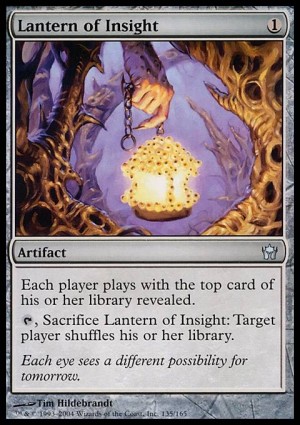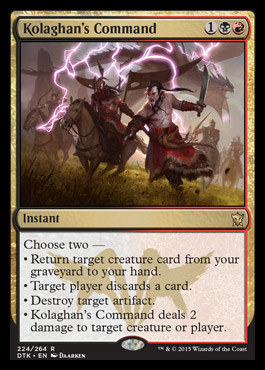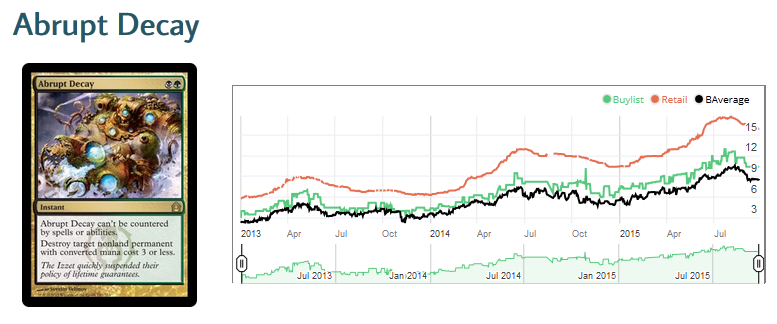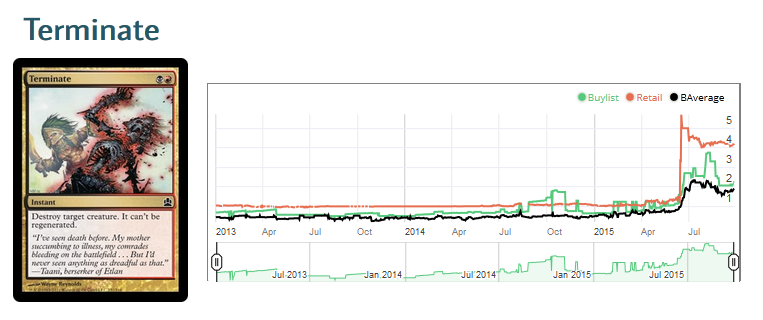Are you a Quiet Speculation member?
If not, now is a perfect time to join up! Our powerful tools, breaking-news analysis, and exclusive Discord channel will make sure you stay up to date and ahead of the curve.
There was a time in Modern's history when the "off-season" didn't just mean fewer tournaments and less format coverage. It meant zero events period, along with a complete shift to Standard and Limited content.
That was back in 2012 when Jacob Maynard had just won Grand Prix Columbus and we had to wait almost five months for the next North American Modern action at Grand Prix Chicago. We had a Scapeshift unban in between, along with Shouta Yasooka's innovative Eternal Command deck, but the average player felt stuck at kitchen table Modern while waiting for the next big event.
 That's no longer the case today. With multiple StarCityGames IQs every weekend, on top of SCG Opens, PPTQs, and events like the World Magic Cup Qualifier series, there are constant opportunities for Modern players to play their favorite format. We even have some big events a mere 2-3 months away: the SCG Open in Dallas on October 31 and Grand Prix Pittsburgh on November 20. Plus Lantern Control just won a GP!
That's no longer the case today. With multiple StarCityGames IQs every weekend, on top of SCG Opens, PPTQs, and events like the World Magic Cup Qualifier series, there are constant opportunities for Modern players to play their favorite format. We even have some big events a mere 2-3 months away: the SCG Open in Dallas on October 31 and Grand Prix Pittsburgh on November 20. Plus Lantern Control just won a GP!
That's right. It's a great time to be a Modern player.
Even though the off-season isn't as pronounced as it once was, the months between Modern events still see a small reduction in format interest and articles. That's no longer a big deal for tournament players (you'll still have a lot of events to choose from), but it's huge for the Modern newcomer who wants to buy into an old deck.
It's also an important time both for veteran Moderners who want to switch to another list, and for savvy investors who want to sneak in when format hype is low.
In today's article, I want to identify two areas of Modern worth buying into during an off-season. I'll talk about these areas both generally, so you can apply the buy-in principles to any Modern metagame, and with some specific examples, so you know what cards to go after right now. This will get our minds off the disappointing Battle for Zendikar release and back to the hot Modern cards we should be paying more attention to.
Investing in "Boring" Tier 1 Decks
In any Modern metagame, you'll find a few Tier 1 decks getting all the attention. Since early summer, those two decks have been Grixis Control and Affinity, both of which enjoyed considerable success since June and going into September. I wrote a number of articles on Affinity's recent rise on the Modern Nexus site, recently one on Worlds and one on Grand Prix Oklahoma City, emphasizing Affinity's renewed strengths in a metagame that doesn't currently respect it.
 As for Grixis Control, this deck has been the talk of Modern since Kolaghan's Command hit the scene. Although Grixis Control didn't see significant success at Worlds, the recent SCG Opens in Charlotte and Cincinnati, or even GP Oklahoma City, this is not because the deck is bad. Rather, it's because Grixis is so prominently on everyone's radar that the format is hyper-prepared for all those Gurmag Anglers and Snapcaster Mages.
As for Grixis Control, this deck has been the talk of Modern since Kolaghan's Command hit the scene. Although Grixis Control didn't see significant success at Worlds, the recent SCG Opens in Charlotte and Cincinnati, or even GP Oklahoma City, this is not because the deck is bad. Rather, it's because Grixis is so prominently on everyone's radar that the format is hyper-prepared for all those Gurmag Anglers and Snapcaster Mages.
Decks like Grixis Control and Affinity may be strong in the metagame, but that also makes them bad investments in an off-season.
Even though many players have turned their attention away from Modern as a whole, these big-name decks are too present in players' minds to be cost-effective. This is particularly true with Affinity: players are overvaluing the deck's cards in light of its recent successes and all the attention it's receiving. Just look at Arcbound Ravager to see that effect in action.
You'll see similar upward trends for other Affinity and Grixis Control staples, including Kolaghan's Command, Inkmoth Nexus (particularly following Infect's win at SCG Cincinnati), and Glimmervoid (also a victim of Lantern Control's success). You can still get into these cards if you want to play the decks, but you'll probably be spending more than the card would be worth absent all the surrounding hype.
So which Tier 1 decks should you spend money on? The reliable, time-tested, and oftentimes downright boring decks that aren't currently on center stage.
Decks like U/R Twin, BGx Midrange (Jund or Abzan), and Burn are easy to forget about when all eyes are on shiny Lantern of Insight finishes or all that Cranial Plating-powered damage. That's good news for the proactive Modern investor. These decks are often just as powerful and reliable as they were earlier in the year, which makes them great buy-ins no matter what else is happening in the format. They will also, all things being equal, continue to be powerful and reliable if new cards or strategies get introduced to the format.
When players focus too much on decks like Affinity and Grixis Control, or flavor-of-the-month decks like Lantern Control, Amulet Bloom, Grishoalbrand, etc., other Tier 1 prices can drop. BGx is a great example of this today.
Back in June, Jund was getting a lot of attention as the deck to beat, with many writers and players narrating a format-wide shift from the Abzan highs of February to a Jund reign in June. You can see this in Liliana of the Veil's price uptick in late May (which had undergone a massive price spike earlier in April when it became clear she wouldn't be in Modern Masters 2015). Once the buzz dies down, however, the cost of those decks' staples tend to die down with it.
Take a look at Abrupt Decay's price dip in the middle of the 2015 summer as fair-weathered players shifted their focus to Grixis and other decks.

The dip at the end of the graph isn't big, but it signals a sustained decline that is likely to continue well into November and December. You can capitalize on that as either a buyer or a player who simply wants to get in on BGx when prices are more reasonable.
When investing in the "boring" Tier 1 decks, look for iconic deck staples like Abrupt Decay and then look to buy in when the spotlight has moved on to something shinier. In Decay's case, this drop is likely to continue well into November as players forget how important BGx Midrange is as a metagame pillar and instead keep thinking about Grixis, Affinity, Lantern, the Knight of the Reliquary plus Retreat to Coralhelm combo, etc.
Of course, there are always confounding variables at play to consider: Decay is a mainstay removal spell in the Lantern deck itself, which will surely affect its price too.
Following this model and paying attention to Jund and Abzan (especially Abzan, which has largely fallen out of favor relative to Jund over the summer), here are some BGx cards worth looking at as the off-season progresses:
B/G Midrange Staples
You can apply a similar method when looking at staples from Twin or Burn. The key is to identify mandatory cards that are also not widely played in other decks, especially the flavor-of-the-month decks. Inquisition of Kozilek and Kolaghan's Command would not make these lists because they are seeing a lot of attention elsewhere (Lantern Control and Grixis respectively).
A Burn card like Goblin Guide, however, is a better example. Guide's price has retreated from its post-Modern Masters 2015 spike to a steep but more reasonable $25-$30. A Battle for Zendikar block or Commander/Duel Deck reprint would torpedo the price, but as cards like Guide continue to drop and attention continues to stay away from the "boring" Burn deck, these staples become much more attractive.
Investing in Generic Format Staples
Tier 1 mainstays aren't the only cards that make good off-season pickups. You'll also find everyday Modern staples like Bolt and Path hold value from metagame to metagame. These cards are typically removal, cantrips, countermagic, or other Modern generics that you'll see in decklists and not think twice about. This makes them mandatory for decks at every level of Modern gameplay, and makes them good off-season investments for both players and re-sellers alike.
The Usual Suspects in Modern
Why buy these cards in the off-season as opposed to any other time in the Modern calendar? The answer is because demand is much more predictable when you don't have big tournaments on the horizon.
These so-called Modern generics spike in the leadup to a Grand Prix or SCG Open when people realize, often at the last minute, they can't play the awesome new Grixis Twin deck without some random Terminates and Lightning Bolts. Players are so busy buying into the hyped hallmarks like Kolaghan's Command that they forget you can't play Kolaghan's without the support cards.
Speaking of the Grixis staple, let's look at Terminate's summer trajectory to see this principle in action.
 Grixis Control saw a massive metagame share increase in early June, following Patrick Chapin's 9th place finish at GP Charlotte. Chapin had been vouching for Gurmag Angler and Tasigur, the Golden Fang ever since a disastrous performance at PT Valencia with an Esper Delve list. With Grixis Control, the strategy entered a new level. Grixis decks had already been pushing the cusp of viability for months, chiefly on the back of Grixis Delver's MTGO successes, and Chapin proved there was a new direction the deck could pursue.
Grixis Control saw a massive metagame share increase in early June, following Patrick Chapin's 9th place finish at GP Charlotte. Chapin had been vouching for Gurmag Angler and Tasigur, the Golden Fang ever since a disastrous performance at PT Valencia with an Esper Delve list. With Grixis Control, the strategy entered a new level. Grixis decks had already been pushing the cusp of viability for months, chiefly on the back of Grixis Delver's MTGO successes, and Chapin proved there was a new direction the deck could pursue.
Terminate's stock soared as players jumped over to the deck. Jund's parallel rise didn't help matters much, as players like Reid Duke and Brad Nelson continued to advocate for its relevance even in a Tron-, Amulet Bloom-, and now Grixis-packed format. These complementary forces pushed Terminate from a sub-$1.00 common to a $5.00+ dollar Modern staple.
Fast forward to today: Terminate has stabilized at a more reasonable price and is likely to continue to drop.
June 2015 would have been a terrible time to buy into Terminate. Everyone was trying to climb on either the Jund or Grixis hype-train, even though no one initially realized that a Grixis or Jund uptick would also lead to that parallel Terminate price rise. Today, you'll still have to shell out $3.50-$4.00 for the card, but I expect that to drop to at most $3.00 by the time the November and December events return Modern to the spotlight.
Price memory is very real in Modern, and once a card carves out a niche as a format mainstay it establishes a floor under which it never drops. This often happens no matter how many times a card gets reprinted: Lightning Bolt is never going to get under that $2.00 mark. That said, these cards return to their floor during the off-season, which is exactly when you want to buy them.
As the format's popularity continues to grow, demand for Modern generics will grow with it. Off seasons are the only time these prices will slip back down, which is the perfect moment to make cost-effective buys.
Other Modern Off-season Investments?
There are plenty of other opportunities for enterprising Moderners to make smart buys during the off-season. Tier 2 decks alone offer a wealth of possibilities. Strategies like Merfolk (admittedly a fringe Tier 1 deck in certain metagames) tend to be strong value-holders no matter what else is happening in Modern.
You can also try and get ahead of metagame trends by sneaking into Tier 3 or untiered decks before they hit the content sphere. I'm looking at known entities such as Death and Taxes and Living End, but also lesser-known options like Nykthos Green or Skred Red.
What other Modern prospects interest you during the off-season? Any decks or cards you have your eyes on? I'll be checking the comments to get your feedback. In the meantime, keep up the brewing and deck development as we get through the off season and into the main Modern action in November!






So would it be wise to sell any affinity staples now and wait for them to drop back down at a later date?
Price memory is very real in Modern, and it’s possible that the Affinity staples won’t drop too much following this spike. That said, I don’t think the Ravager price is sustainable in the longrun, which makes that card a decent offload target. Inkmoth Nexus, however, is the kind of card that is likely to stay high. It sees play in two big Modern decks and a big Legacy deck: sell those at your own risk.